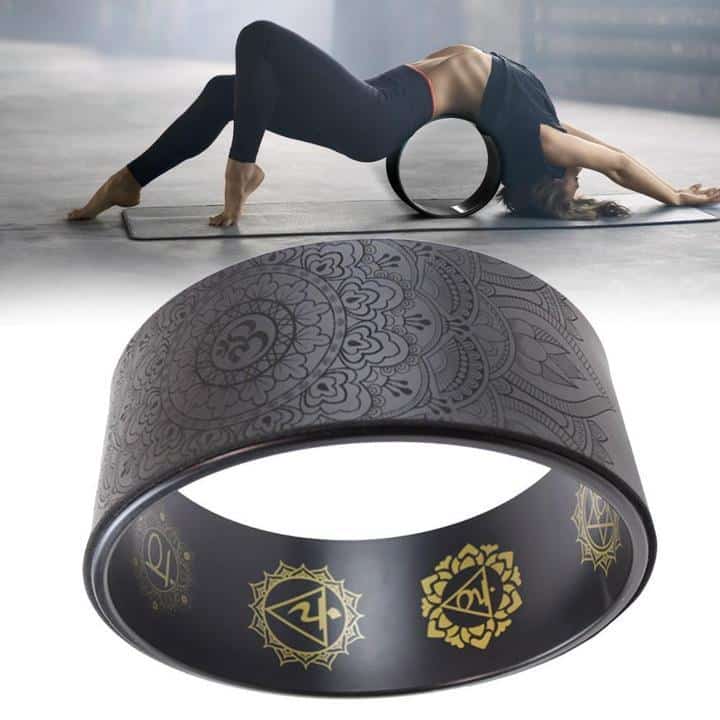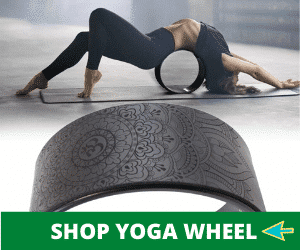Is yoga wheel good and what are the benefits of yoga wheel?
Flowing in yoga practice invigorates both body and mind, leaving an irrevocable feeling of deep focus. For the ultimate yoga experience, a famous US yoga instructor created a prop that is sure to strengthen your yoga practice, whether you are a novice or a well-trained yogi. Ever since its launch, the yoga wheel has been catching on across the world.
What size are yoga wheels and how much weight can a yoga wheel hold??
The roller comes in small, medium and large size, and is known to withstand up to 500 pounds. While the small wheel is used to massage target areas, medium works better in toning exercises, and the widest wheels are perfect for boosting balance. With a weight of only 4 pounds, it is a very convenient prop to carry around hopping from one studio to another.
Do yoga wheel help back pain?
Users have found it not only aesthetically appealing but also highly beneficial for improving postures and relieving back-pain issues. Resting on the yoga wheel while massaging the back was proven to release the pressure off the spine, improving the posture.
What is a yoga wheel used for?
The yoga wheel comes in gorgeous materials and designs, that were made to help you get deeper into the asanas more quickly and safely.
Having said that, it’s high time to refresh your yoga routine with these yoga wheel-inspired exercises.
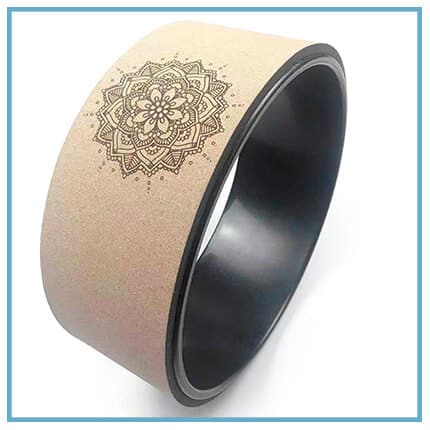
Yoga Wheels for Back Pain
Yoga wheels for back pain are the perfect yoga accessory. With yoga wheel, yoga practitioners can open up their chests and improve flexibility in their backbend poses. Not only does this assist in reducing and relieving back pain, but it also helps to strengthen and increase flexibility in other postures. A yoga wheel serves as a support to maintain balance while stretching certain muscle groups that would be hard to achieve without the wheel. Not only will yoga wheel help build and tone your core muscles, but it also helps create deeper engagement when you practice yoga and encourages relaxation in order to obtain a greater range of motion compared to regular yoga practice. Moreover, yoga wheels are great for any yoga student looking for an invigorating way to enhance their physical exercise routine and progress further in their yoga journey. Learn How to Use a Yoga Wheel
1. Wheel Assisted Standing one leg beginner
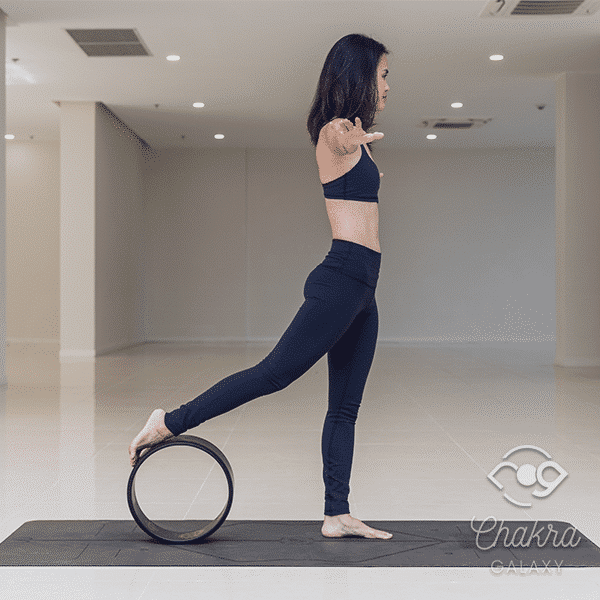
To do this easy balancing posture, make your way to the front of your mat. As you exhale bring one leg onto the yoga wheel, so the front part of the foot is pressing into the roller. The other leg is straight and you are gazing forward. Spread your arms in level with your shoulders and take several yogic breaths. Change sides as you remain focused on one point in the distance that will help you maintain the balance. One-legged postures help you find the center of gravity. Since it might take longer to do so without the use of props, the yoga wheel makes the perfect, solid foundation on which you can build and improve your yoga practice. It doesn’t matter how many times you lose the focus and fall, always come back to try again, as your body tends to activate the muscle memory system every time you exercise.
2. Wheel Assisted Warrior pose II (Virabhadrasana II)
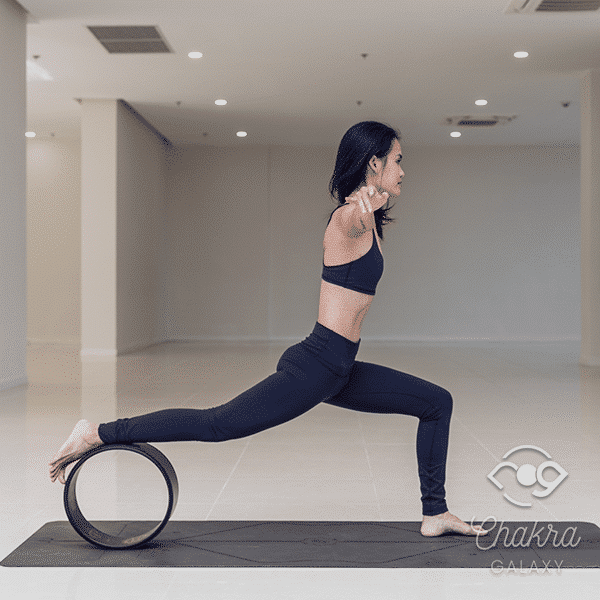
Lift your arms and align them with the floor. As you take a deep breath, send one leg to the back and rest the ankle on the yoga wheel. Go as low as your body allows you, keeping the other leg erect. Keep the knee in a 90-degree flexion, as you want to avoid injuries. Focus on a still object in the distance that will enhance your attention as you slowly start increasing the duration of the posture. Virabhadrasana II is known to promote focus and strength, which is the basis of every other yoga posture. Ideally, you could use a medium-sized yoga wheel to help you tone the legs, as you move lower, without touching the floor. Using the roller in this asana will test your endurance and balance, as it is both fun and challenging to stay still. The benefits of this pose are numerous, from promoting good circulation to blood flow stimulation, which results in a healthy respiratory system.
3. Wheel Assisted Plow pose (Halasana)
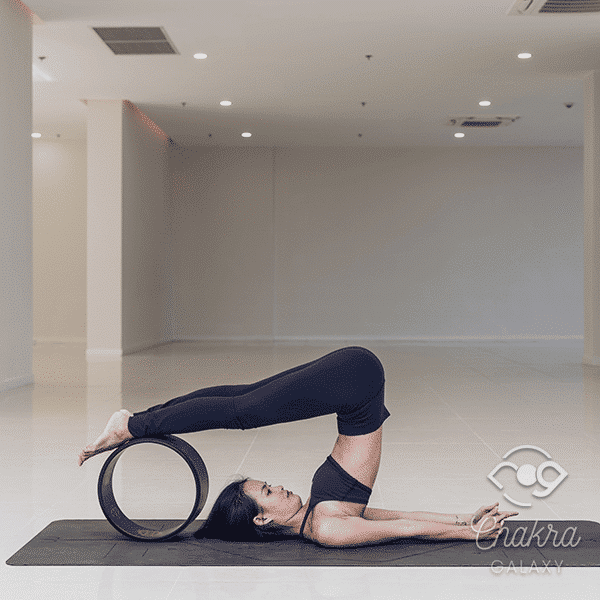
Lie down comfortably on your back. On the next inhalation lift both of your legs. You might place your hands under your buttocks, and bend your knees if you find it hard to get in the posture. As you exhale lower your legs to the floor, above your head. Try to stay still in the position with the help of your hands, interlaced behind your back, firmly pressing onto the mat to help you remain stable. Drawing your chin away from the sternum, as you slowly push the tights to the celling will enable you to sink deeper into the pose that is known for its multiple therapeutic benefits. When done regularly, Halasana can increase spine flexibility, while at the same time, supplying the nervous system with a fresh blood supply. The final results are curing severe headaches and sinus infections. If your knees and hamstrings don’t allow you to touch the floor with your toes just yet, this prop has got you covered. Using the roller to get into the posture is, therefore, very beneficial for those don’t get to experience the amazing advantages of this asana.
4. Wheel Assisted Cat-Cow Pose (Marjaryasana)
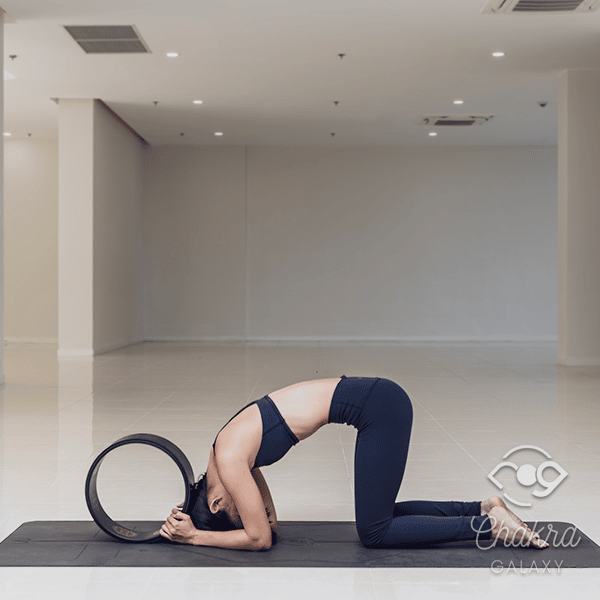
Grab the base of the wheel firmly with both hands. Come to the tabletop position, making sure your hands are parallel with your shoulders, and knees perpendicular to the floor. Breath in as you tuck your tailbone upwards, gazing to the sky, pushing the navel downwards. Now instead of forming a regular bow, go deeper into the posture by hunching your shoulders and lowering your head so it touches the roller. The cat-cow pose is one of the best-known poses that soothes the lower back pain. Combined with some of the rollers available on the market, it can enhance and speed up the recovery. To feel the benefits of this asana, repeat the movement in the time frame of two to three minutes. Remember to breathe in as you draw the navel in, pulling shoulders apart and looking up. Exhaling, you arch your back like a cat, tuck the chin in to stimulate the thyroid gland and look down. Marjaryasana doesn’t only massage your spine but it also strengthens your core as you contract the muscles every time you exhale.
5. Wheel Assisted Headstand (Sirsasana)

Get a firm grip of the wheel from Balasana with your arms stretched forward, and your hips comfortably resting on your heels. Close your eyes and take a couple of deep breaths. Place your head on the floor, right in front of the wheel. Bear in mind that not the head, but the hairline will support the body in the inversion. Grab the roller on both sides and feel the back of your head touching the yoga wheel. On the next inhalation, lift your legs, knees straight, and walk towards your head. Rely on your forearms as you lift off one leg at the time close to your chest. Once in the knee-bent inversion, try to straighten your legs in line with the body. Pull the roller towards your head as you use your core to lift higher. You can also place a yoga block in front of the wheel if you want to create a strong support structure. The yoga wheel is a great prop for practicing headstand variations, as you will have a solid base to protect you from the fall in case you lose balance. If there is none to help you practice headstand, then the second-best option you have is to get your hands on the props that will take you to the full posture in no time.
6. Wheel Assisted Warrior Pose I (Virabhadrasana I)

Similar to Virabadhrasana, you will get into the posture from Tadasana, the mountain pose. Stand at the top of your mat, legs hip-width distance apart, tailbone tucked in, and the upper part of the body elongated. Palms are facing up, slightly away from the body. Roll the wheel under your body, and when inhaling, step back, placing the front part of the leg on the wheel. Feel the stretch in your psoas muscles as you draw the lower belly in and up. On the exhalation, rotate your torso to the front so your pelvis is parallel to the floor. Draw the shoulders away from the neck as you bring your arms up with hands in the namaskar position. Keep your chest lifted and try to sink deeper into the pose with every following breath. Virabhadrasana is a great posture for stretching your arms, groins, and ankles, while at the same time, building up strength in your arms, legs, and shoulders.
7. Wheel Assisted Advanced Crescent Pose (Anjaneyasana)

Anjaneyasana is very similar to the previous pose and is usually done before the warrior series. You can flow to the crescent pose from the warrior, by engaging the core muscles that will help you stay still. The medium wheel is a good choice for this posture, as it facilitates the freedom of movement. As you lunge back, roll the wheel further back so you can relax in the pose. Bend the knee, and reach out with the respective arm to grab the toes. The other leg is at the 90-degree angle, firmly planted on the ground. Lift the respective arm at about a 120-degree angle. Retain the back arm in a horizontal position, and keep on lengthening your lower back. Roll your shoulders away from the ears and engage the core. The lower you go, the more intensive the stretch becomes. You can make this pose more challenging by looking up in the sky or even closing your eyes. By practicing the advance crescent pose, you will feel the front part of your body expanding, energizing your whole body. This heart-opening posture has also positive effects on reducing fatigue and yoga calories burned.
8. Wheel Assisted Bridge on the Head (Setu Bandha Sirsasana)
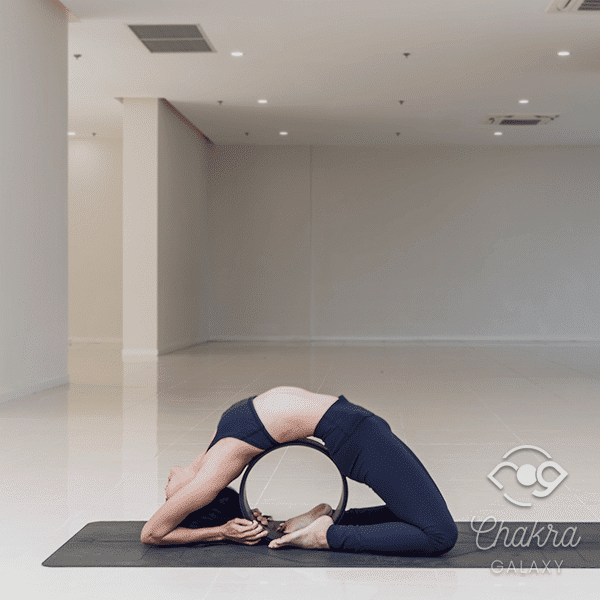
Come onto your knees, hip-width distance apart, and place the wheel behind your back, in between your feet. Support the roller with the lateral part of your feet. Use your hands to stabilize the roller as you sit and lean back. Exhaling, roll your spine over the wheel, pushing the shinbones against the floor. As you lower your head on the floor, make sure your chin is safely tucked before the upper part of your skull touches the mat. Arms are over the head, as you work on bringing the elbows closer together. Your aim here is to deepen the stretch in the hip flexors, as well as the upper and lower back while grabbing the roller firmly with both hands. Bear in mind that the best yoga wheels for the backbends are 12 inches high and about 5 inches wide. It is important to get out of the posture by bringing your hands to the soles of the feet, as you prepare to propel yourself and sit back up. Don’t make hasty movements when getting out of the back-bends, and always release the pressure on the spine by taking the child’s pose.
9. Wheel Assisted Fish Pose (Matsyasana)
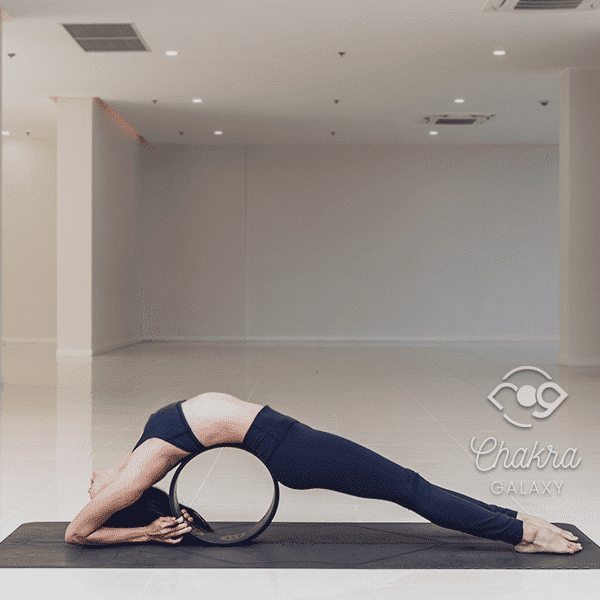
Before getting into the posture, you can massage your spine in a series of warm-up exercises, rolling up the spinal column up and down. Take your time to prepare while readjusting the wheel and tunning in with your breath. Once you explore what feels good, you can either go back, sit down and plant your feet in front of you, or simply grab the yoga wheel while you are still up, with your hips high off the ground. Either way, once you get a firm grip, start straightening up your legs with control. Sink in the pose deeper step-by-step, correlating with the breath. With the help of your hands, gently roll further back until you feel a nice stretch. Let your tailbone and middle spine rest on the wheel, as your chest opens up. Don’t let your elbows drift apart, try to engage the forearms to keep them closer together. Hips should rest comfortably on the wheel, as the anatomical focus is on the back. Don’t strain your neck, but try to keep it in a relaxed position to help you stay in the posture for about three minutes.
10. Wheel Assisted Toe Stand (Padangusthasana)
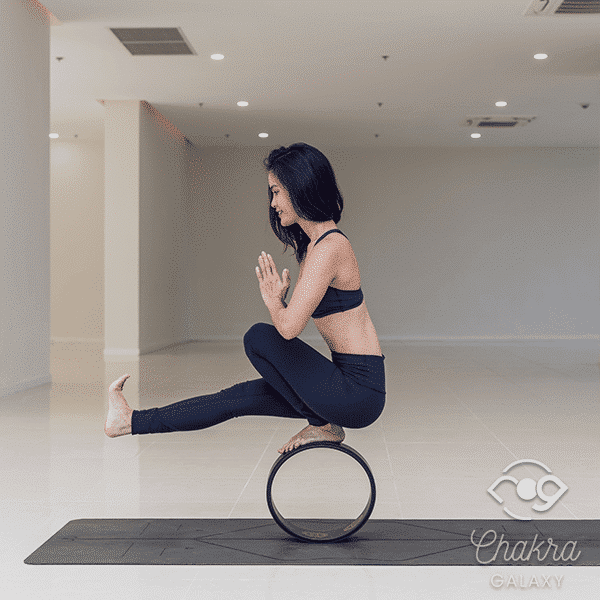
Don’t get fooled by the serenity of this posture, you will need a strong core and open hip flexor just to try to balance on the wheel. Refrain from the exercise if you feel pain in the lower back, as you might easily fall and injure yourself. Roll the wheel left and right with your foot just get a feeling of the texture. Hold the front side of the wheel as you move one leg to the top. Follow with the other leg as you try to keep the balance, focusing on one spot. Soles of the foot should be firmly grasping the wheel surface, as you lean forward, with your shoulders away from the ears. Erect one leg and keep it in the air with toes flexed. Press your palms together and bring your head in alignment with the neck. Practice this posture until you can stay still on one leg, as it promotes healthy and flexible joints, and improves the overall body posture.
11. Wheel Assisted Garland Pose (Malasana)

To get into the garland pose put one leg on the roller, and use both hands to balance before raising the other one. In this pose, feet are adjusted to the shape of the wheel, with toes pointed outward away from each other to help you stay still. Bring your hands from the center to your chest, pressing against the sternum to support the distribution of the breath to the body through the heart. Try to extend the lower back, as you open up your chest by pushing the shoulder blades away from one another. Maintain a fixed stare at the motionless object in front of you. Malasana keeps your pelvic region healthy, which makes it one of the most important asanas in prenatal yoga. It will also stretch your groins, hips, ankles, and torso, improving the elimination through the colon and increasing the blood flow in the body.
12. Wheel Assisted Standing One Leg Advanced (Utthita Eka Padasana)
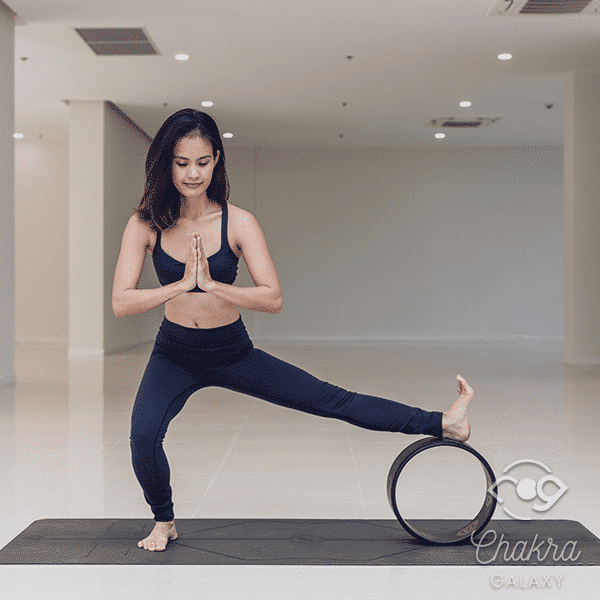
First, get into the extended one leg posture. Then you lift and bring one leg in front as you inhale. Keep your hips square as the other leg remains on the floor. While exhaling, don’t lean back as you move the extended erect leg to the side, to rest on the yoga wheel. Bend the other standing leg so the knees don’t go over the tip of the toes. The hands in front of you are pressed in gentle prayer as you try to sink deeper with every exhalation. Repeat the same movement on the other side. Introducing Utthita Eka Padasana into your yoga routine will significantly improve the digestive power in the body. Also, those who find the posture challenging will be able to experience its full benefits in this modified version, with the help of the yoga wheel.
13. Wheel Assisted Modified Plank Pose (Phalakasana)

You can easily transition to Phalakasana from the tabletop position, keeping your hands aligned with the shoulders, as you push the floor away with all 10 fingers. Engage your wrists and avoid locking the elbows in. Make sure your head is not dropping forward. Your chin is tucked and the head neatly aligned with the upper back. Draw the abdomen into the rib cage while keeping your knees bent. Don’t let your chest collapse, as it would impose a tremendous strain on the shoulder blades. Extend one leg at the time to reach the yoga wheel placed towards the end of the mat. After you place both shinbones on the roller, engage the core and pull the shoulders away from the ears. The core and the shoulders play a crucial role in keeping your body firm and stable in the posture. Phalakasana is known as one of the most powerful postures when it comes to back pain prevention.
14. Wheel Assisted Crow Pose (Kakasana)
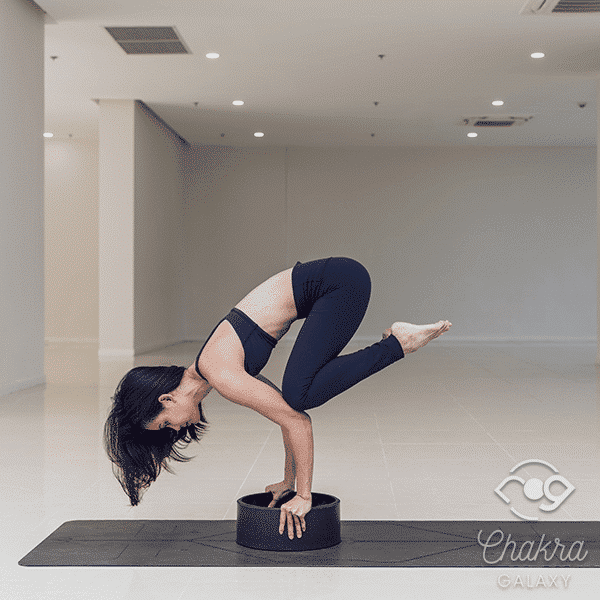
By using the yoga wheel you are ought to feel more pressure in the upper body while doing the crow pose. This time, you will place the wheel so that the brim is resting on the floor. Place both hands on the opposite sides, your body tilting forward, and bend the arms in elbows. Anatomical focus is on your arms and shoulders, so you want to make sure to find integrity in that area. Widen your knees and draw the navel in, towards the spine. As you lean in forward, walk ahead, while keeping your neck nice and long. Search the place where the knee meets the arm. Sway forward and backward until you find the right spot. Gaze forward to gain more stability and avoid falling out of the posture. Lift your right leg and place it in the elbow crease, or the upper arm. Bring the left leg to the other arm and lean forward, putting your body weight on the arms. A fun fact, the secret of performing Kakasana lies in the mental, rather than the physical body.
15. Wheel Assisted Lizard Lunge (Utthan Pristhasana)
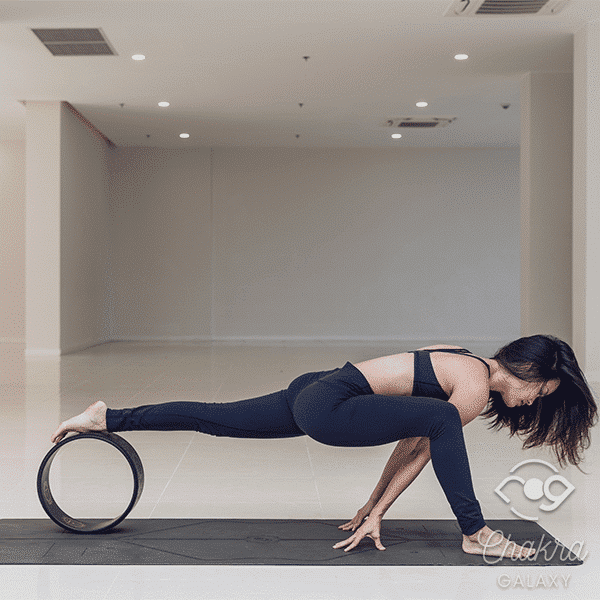
Begin your practice at the top of your mat in the mountain pose. Then step back with your left leg so that your left shinbone rests firmly on the roller.
Bend and open the right leg more to the side, towards the outer edge of the mat. Open up the hip crease as you start introducing full yogic breaths. You can stay in this position for a couple of minutes, easing into the pose. Now put both of your arms on the mat, so that you are balancing on tip of the fingers that are pointing in the direction of the wheel. Keep on extending your arms as you sink lower to the ground. Open the chest to the mat to help you keep the spine straight. Bring awareness to the inner thighs to induce relaxation. Lizzard lunges are fantastic hip-opener exercises that build up the legs, improving the hip ligaments and the overall sense of balance in the body.
16. Wheel Assisted Half Pyramid Pose (Ardha Parsvottanasana)
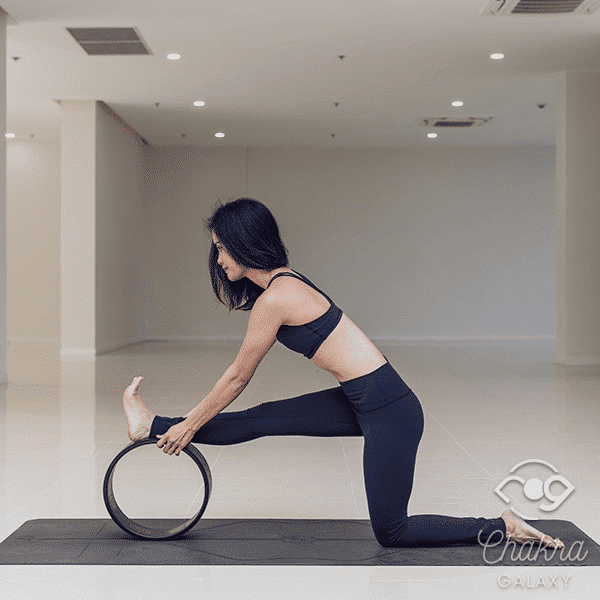
Stand on your knees towards the middle of the mat, and place the wheel at the front. Inhaling, stretch one leg onto the roller in a flexed position, keeping the other leg parallel with the wall. As you exhale, move from the hips as if you are to touch the upper portion of the leg with your belly. Grab the wheel with both hands, somewhere in the line with the ankles. Soften the elbows, as well as your shoulders and face. Keep your spine straight and quads engaged as you sink deeper with every exhalation. Repeat on both sides. You can place a blanket under the knee cap if you find the posture uncomfortable. This pose is known to balance one’s emotional and physical state by keeping the longest and widest sciatic nerve in the body strong and healthy.
17. Wheel Assisted Reclining Easy Pose (Supta Sukhasana)

This posture is not only beautiful on the outside, but also beneficial for the entire body and its internal systems. Supta Sukhasana is performed easier with the support of a yoga wheel. Comfortably resting the upper back, shoulders and the posterior head on the roller helps practitioners recline deeper and open up the chest area. Sitting in any cross-legged position of your choice, hold hands in your lap in Gyan mudra (thumb and index finger touching). Rest the upper part of your body on the yoga wheel and stay in the posture for five minutes, breathing deeply with your eyes gently closed. As the picture itself already explains, this posture is an ideal method for acquiring inner peace and finding tranquility in today’s bustling world.
18. Wheel Assisted Child’s Pose (Balasana)
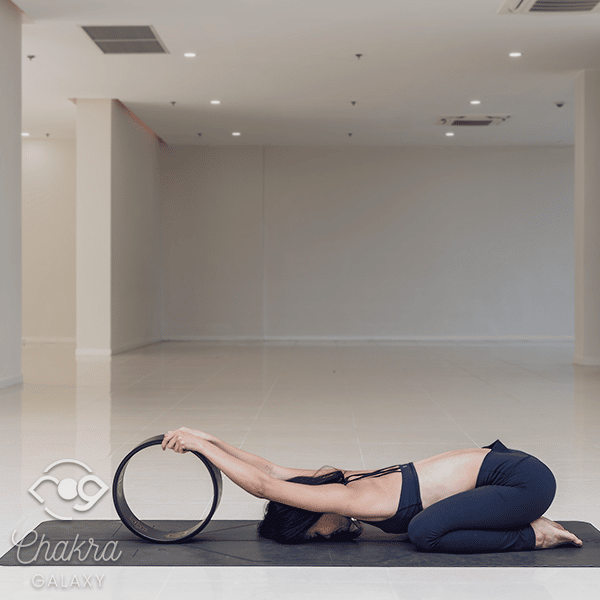
Sitting on your heels, take a deep breath in preparation for Balasana. Spread your knees and soften down the hips to make space for your torso to come down in between. Take another breath as you stretch your arms above your head, gazing up. Breathing out, recline from the hips, lowering your hands to grab the wheel at its highest point. Readjust the upper part of your body on the floor, so that the forehead is touching the mat. Both arms stay in the extended position. Gently push your chest towards the floor to feel a deeper stretch in the shoulder area. Sit bones should stay on your heals in a comfortable position while doing the asana. You can always use a block, blanket, or towel to bring your hips closer to the feet.
19. Wheel Assisted Tiger Pose (Vyaghrasana)
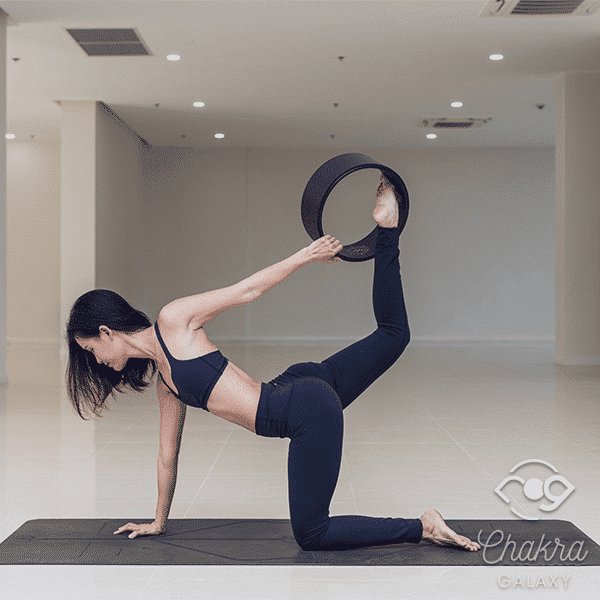
You can do a couple of cat-cow stretches as a warm-up exercise for Vyaghrasana. Starting from the tabletop, inhale, lift and straighten the left knee so it is aligned with your trunk. As you bend the knee, pull the sole of the foot to the crown of your head. Extend the right arm forward. Then use that same arm to hook your left toes into the wheel. Twist the upper body as you extend the right arm, at the same time, actively raising the left knee. The left arm is firmly planted on the mat, pressing into the fingers and knuckles. Focusing on the micro-movements of the left arm and the right leg will help you stay still in the posture. Keep both of the hips parallel to the ground to experience the full benefits of the posture. Breath normally and hold the pose steady for as long as you can. Push the arm and the leg in the opposite directions, as if someone is pulling you apart.
20. Wheel Assisted Boat Pose (Navasana)

Sit on the ground and rock back into the boat pose. To get into the proper alignment, make sure your core is engaged, lower ribs tucked in, and sit bones pressed down firmly. Lean the roller into the left lower part of the leg. Then, move the right leg just below the wheel, fingers pointed to the wall. The left foot is flexed, and the opposite arm is turned to the ceiling. Your spine is erect and the chest is reaching forward. As the yoga wheel helps you keep the balance, you can solemnly focus on breathing and deepening the pose. If you are a beginner, you can keep your arms on the floor. The most important thing about this pose is to avoid leaning back. This advanced posture is well-known for its core strengthening and stress-relieving benefits.
21. Wheel Assisted Side Bend Pose (Urdhva Hastasana)
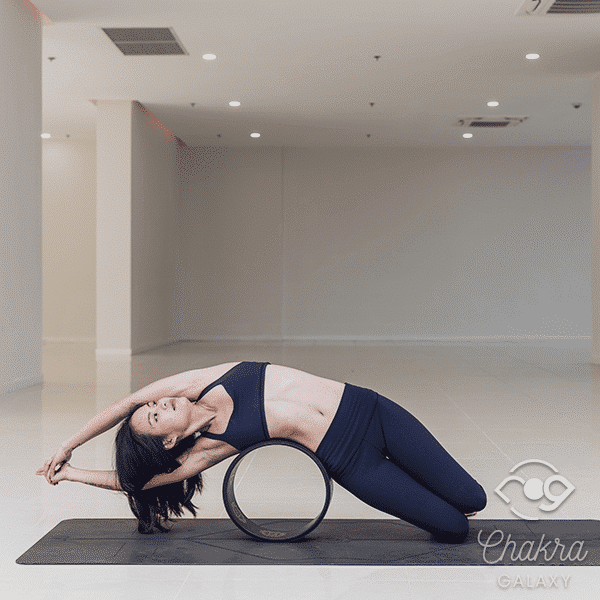
Place the wheel on your right as you get ready to bend over the roller. Inhaling, raise your arms above your head, stretching your whole upper body. Stay there for a couple of breaths, keeping your mind alert. On your next exhale, rollover on the side, activating your external oblique on the right. Your arms stay above your head interlaced in Ksepana mudra, with the whole right rib cage pointing upwards. The knees are stacked on top of each other, with the right knee placed on the ground. The other knee is slightly off the floor as the body is leaning on the opposite side. The arms are not touching the floor, and the elbows are straight. Focus on one single point in the ceiling and activate your Drishti. Urdhva Hastasana is said to have therapeutic importance in removing diaphragm congestion and clearing up the toxins from the airway passages. The upward salute is even said to be that powerful that it could cure acute asthma.
22. Wheel Assisted Split Leg Entry Headstand (Sirsasana)
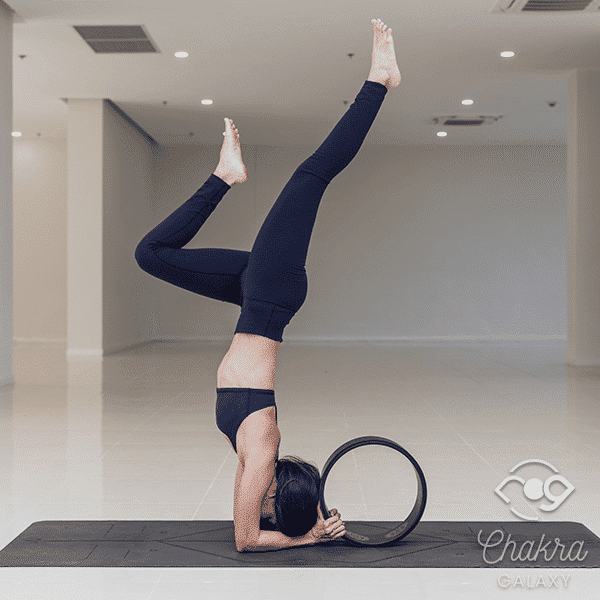
Practicing Sirsasana with the yoga wheel is sure to help practitioners feel more confident in the posture without using the assistance of the wall. Come to all fours and hold onto the base of the wheel for support. You want to place your forearms under the shoulders, forming a triangle shape. Your head is on the mat, gently pressed against the roller. The shoulders are actively moving away from the ears as you start lifting your hips to the sky. Take several micro-steps towards the direction of your face and once you can’t go further, bend one knee and lift both legs away from the floor. Extend your right leg and leave the left knee bent. Counterbalance the posture by squeezing the back of your head onto the wheel. Activate your arms, neck and the core to lengthen your spine that will keep you stable in the inversion. Always relax in child’s pose after Sirsana, bringing the body to rest.
23. Wheel Assisted Pike Up Version Hand Stand (Adho Mukha Vrksasana)

To get into the handstand, press your hands firmly onto the ground and place both legs on the wheel. Extend your shoulders and tuck in your pelvis. Tip your body forward as you lift one leg away, focusing on the fingertips and grip strength. Externally rotate the arms, with the sacrum pointing towards the sky. Activate bandhas and elongate through the right leg, as you balance on your left toes. Draw your navel in towards the spine and open up your armpits, as well as your chest, to align properly. Handstands play a vital role in blood purification and immune system enhancement. The ability to engage your whole body to glide into the posture will, therefore, be one of the clear indicators of the effectiveness of your yoga practice.
Where to buy a yoga wheel?
-
 PP Wooden Pilates Yoga Wheel for Back Workout & Spinal Massage
PP Wooden Pilates Yoga Wheel for Back Workout & Spinal Massage -
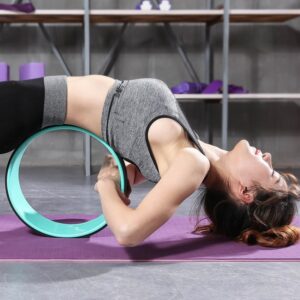 Unique Back Pain Roller Yoga Wheel for Posture
Unique Back Pain Roller Yoga Wheel for Posture -
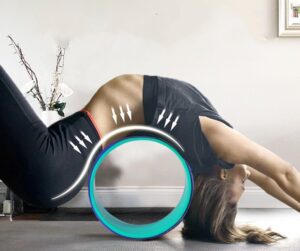 Dual Color Auxiliary TPE Non-Slip Eco-Friendly Yoga Wheel
Dual Color Auxiliary TPE Non-Slip Eco-Friendly Yoga Wheel -
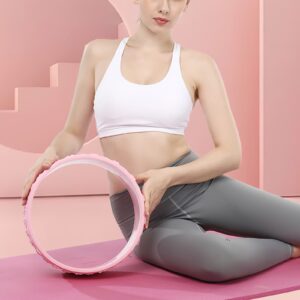 Pink Bee Pattern 3D Back Massage Cute Yoga Wheel
Pink Bee Pattern 3D Back Massage Cute Yoga Wheel -
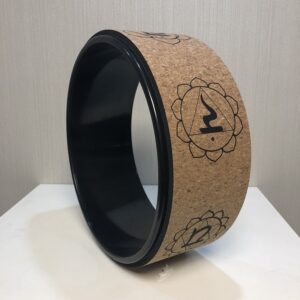 Seven Chakra Symbols Cork Yoga Wheel for Flexibility + Bag
Seven Chakra Symbols Cork Yoga Wheel for Flexibility + Bag -
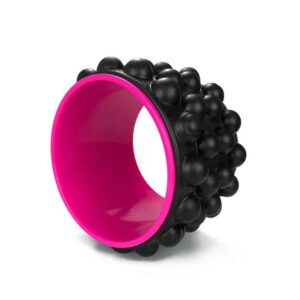 Back Pressure Point Massage Yoga Wheel for Backpain
Back Pressure Point Massage Yoga Wheel for Backpain -
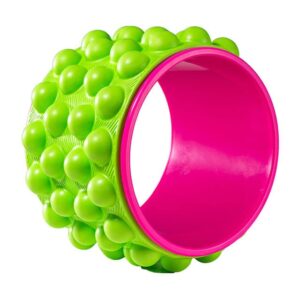 Dual Color Pressure Point Back Roller Yoga Wheel for Back Extension
Dual Color Pressure Point Back Roller Yoga Wheel for Back Extension -
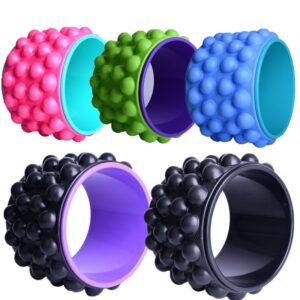 Ultimate Back Roller Pressure Points Pilates Yoga Wheel
Ultimate Back Roller Pressure Points Pilates Yoga Wheel -
 Green Pink TPE Non-Slip Yoga Wheel for Flexibility
Green Pink TPE Non-Slip Yoga Wheel for Flexibility
The rollers are widely available in online yoga stores as well as your local yoga studios. We recommend you check our best selection of yoga wheels.
In addition to that, you can also check out our Yoga Mats, and Yoga Pants & Leggings collections.

—
Photos by Pierre Ogeron
Model: Anh Ngo

